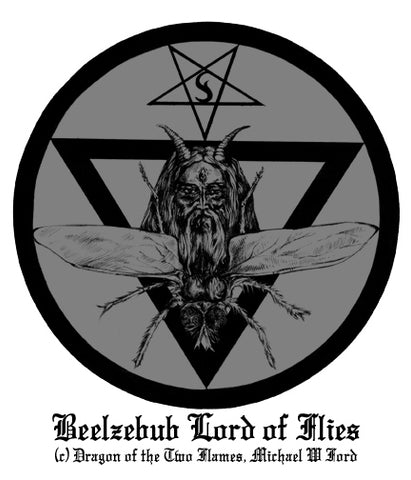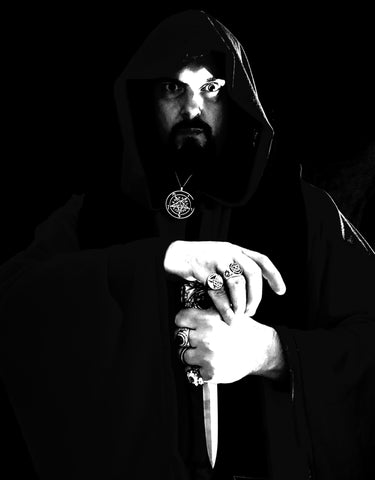Non ci sono articoli nel tuo carrello.
Luciferian Magick is a culmination of rational philosophy, pragmatic application of the ethos of Will to Power, Adversarial Metaphysics and the ceremonial theory and practice of Magick. For those seeking entry through the darkly shining gates of Pandemonium (initiation), self-mastery and the Adepthood of the Triad of the Morning Star precedes ceremonial and sorcerous practices with the majority of Deific Masks and spirits. This challenging foundation is a process of what could be called High Magick or Greater Black Magic, correctly noted as Apotheosis (becoming a god or goddess) and in the subtlety and slow process of compelling internal change and self-transformation, commonly is missed, unrecognized or disregarded for the vastly more stimulating glamour of ceremonial and ritual Magick.
Identifying with the Luciferian Philosophy, as defined in the 11 Points of Power, is a culmination of the foundational traits and symbolism revealing the essence of the Luciferian, so enhanced (and in-turn reciprocating energy) exalts and luminates the Black Flame. Keys of Power are found in the recesses of the mind and offered to those who have the skill to recognize and interpret that so given to us in the outer world. My initiatory work and subsequently, publications, possess a specific patron spirit within each grimoire, potentially revealing a crooked path beyond shadows so exalted from the gifts of Beelzebub (in the Deific Masks’ many Names and Forms).
The Black Flame or Black Light is that initial spark of self-awareness, consciousness and the ability to perceive as an individual, especially applying the techniques and teachings of the Deific Masks so found in our vast Pandemonium. Luciferianism has roots in many pantheons, religious ethos and magical practices in antiquity, including Greco-Roman, Hellenistic, Persian, Celtic, Norse, Germanic, Slavic, Egyptian and Arabian mythologies.
The Light Bearer has many masks and symbols which possess a specific type of power, energy and force; some are creative, inspiring and equally destructive and predatory. Like humanity, the Adversary has many moods, faces and forms throughout history, religion and myth. Luciferianism uses the wealth of knowledge and technology of this age to interpret the Adversarial Spirit in balance with both Magick and Science, evolving the Luciferian Path with many different paths and roads to explore.
The Watchers from the myth of Enoch I, Samael and Lilith from Hebrew lore (the Adversaries of monotheism and especially the Abrahamic religion of Yahweh), the cloaked shadowy demonic spirits so despised in modern religion and more. Luciferians are varied and highly individualistic, some may have different ways of perceiving and exalting the Black Flame including how the Triad of the Morning Star is applied.
In my work, “BAAL AND THE MASKS OF POWER, Black Magick and Initiation with the Lord of Flies” featured in “BEELZEBUB: Lord Of The Flies, Compendium 6” (Become A Living God Publishing), I focus on the subtleties and meaning behind the symbols of Beelzebub. From the Hellenistic period and surviving well during the renaissance period, the Christian Bible contributed some to symbolize the traits and essence of Beelzebub, Prince of Demons, one of many names commonly associated with Satan.
The Lord of Flies has origins in the Bronze Age Syrian city of Ugarit as well as the Canaanite religion. The religion of ancient Canaan (along with the ancient near eastern world) was a polytheistic one; different cities and regions beheld different deities and often (as time went on), syncretism united many traits and aspects of gods with other identical ones. The powers associated with a deity could be identified by the cult epithet of the specific god or goddess in question.
Baal possesses many traits in the ancient near east, many cities had different Baal’s who had different traits and attributes based on their role in the cult of the area. The epithet of zbl b’l translates, “Baal the Prince”, from Ugaritic tablets and myths of the religious cycle of Baal so preserved and buried in the ancient Bronze Age city of Ugarit. You can easily recognize how “Zebul Ba’al” (Baal the Prince) appears as a mighty storm-god whose powers expand and take different shapes well into the Iron Age through the Medieval period with Christian demonology.
While Beelzebub is an opprobrious epithet of this illustrious deity, there are many parallel translations and meanings of the name of the Prince of Demons, another title of the New Testament Adversary, Satan the “Prince of the Powers of Air”.
The word ba’al means ‘Lord’ and in the Levant, there were different ba’al deities in many cities and regions. The most common was variations of the Canaanite storm god Baal Hadad, known in Ugaritic texts as Baal Zebul. When the Jews conquered Canaan, their singular cult of Yahweh (a storm god) appropriated the myths, imagery, epithets and associations of not only the ancient Canaanite deity EL, also some of Baal Hadad’s traits and lore. The remaining deities of that pantheon were demoted to either subservient angels of Yahweh Adonai (Hebrew ‘lord’) or demons (the sea god Yam, originally the adversary of Baal in the Cycle of Baal became Leviathan).
The noun, Zebub translates ‘flies’ just as the Akkadian ‘zubbu’. The most common association of Beelzebub is ‘Lord of the Flies’ however there are other interpretations of this ancient deific mask as well. The sun in the ancient near east was naturally both beneficial and destructive. Flies were sacred in some areas as they were associated with the Sun; in Israel they were considered a nuisance. The flies as related to Baal were a symbol of not only heat but also the ability to cure and send disease based on the god’s whim and those who by offerings, sought his favor.
Hadad, Haddu and Addu means ‘thunderer’, a conquering storm deity whose authority is not only that of the air, lightning, storm-clouds and rain. In Mesopotamia, Adad is the manifestation of Baal as the storm-god. ‘Aliyn Baal’, an epithet of the god is used to describe the power of which this Deific Mask wields; ‘Aliyn Baal’ translates ‘Mightiest Baal’.
Beelzebub is the “Lord of the Dwelling”, the dwelling or house of evil spirits, simply the enemies of the monotheistic cult of Yahweh. Luciferian Adepts do not limit their scope of tradition to merely one specific ethos; rather it is the Gnosis of the Opposer to interpret the omens and often buried “lore” of those persecuted by the early Christians and monotheistic dogma. Using the dark and baneful symbolism, the balance and origins provide insight to grasp and command the Gnosis of the Adversary as both beneficial and predatory, a Weapon of Magick to be wielded by the sorcerer.
In the context of Luciferianism, evil spirit is a cloaked descriptive meaning any type of energy, force or spirit outside and beyond Judeo-Christian constraints. Evil spirit does not indicate the actual nature (beneficial or destructive) of the daimon/deity/energy. Applying the 11 Points of Power as the dedicated act of initiation early on will reveal the hidden knowledge and balanced perspective required to exist beyond and outside of religious dogma.

In my work published in “BEELZEBUB: Lord Of The Flies, Compendium 6”, Baal in his origins to the syncretism of Beelzebub in modern Luciferian Magick reveal and articulate the meanings behind the epithets and progression of the Lord of Lofty Heights, Lord of Divination, the Storm-God to the Prince of Demons, Sorcery and Black Magic in the ancient near east and eventually carried to the west as the Lord of Flies via Christian religion. Beelzebub is one of the inspiring spirits of the first published Left-Hand Path or Luciferian divination and pathworking tool, the Luciferian Tarot (Succubus Productions 2008).
As the Lord of Flies, the swarm collectively masses together within (and beyond) the Triangle of Evocation in which an Elizabethan Black Magician and Warlock so summons the Patron Spirit of Black Magick. The different types of ceremonial workings invoking specific forms of Beelzebub as the Patron Daemon of Magick are revealed in a concise and purposeful way, the methodology unites divination, demonolatry, black magical invocation and the Triad of the Morning Star.
BEELZEBUB: Lord of The Flies, Compendium 6, published December 31st 2019 by BECOME A LIVING GOD is a part of the Nine Infernal Gatekeepers collection and features the authors and Black Magicians: E.A. Koetting, Asenath Mason, Michael W. Ford, Edgar Kerval, Bill Duvendack, Orlee Stewart, Conner Kendall, Xag Darklight & C.H. Richard, including a forward by Timothy.
Michael W Ford (Akhtya)

It is truly intriguing that this information provides itself when needed, for no where else can this detail and extensive amount of information be found. Thank you so much for doing the incredible amount of work it takes to make these publications.